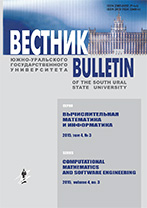|
Computational Mathematics
On the program components of the mathematical modelling
V. P. Il'inab
a Institute of Computational Mathematics and Mathematical Geophysics of Siberian Branch of the Russian Academy of Sciences (Novosibirsk, Russian Federation)
b Novosibirsk State University (Novosibirsk, Russian Federation)
Abstract:
The fast growth of the world supercomputer power obviously directs to the aktive applications of the mathematical modelling in the processes of economics re-industrialization. The extensionof applications and simultaneous appearance of the new numerical methods, accompaining by thecomputer architecture evolution conducts to dramatic increasing of the total applied software,the cost of which is comparable with the expensis of the multi-processor computationsl systems(MPCS). Such quantitative changes leads to qualitive re-considering of the conception andtechnological structures of the software products. We consider the approaches for solving thearising problems in adapting to the basic system of modelling which is oriented to the integrativesupport of the all main stages of the large scale computational experiment. The variety of thetechnological issues includes the providnce of interaction of multi-language and cross-platformprogram components, internal and external interfaces with convertation of the multi-fold datapresentation, reusing the external products, long life circle of the system, evolution of thefunctionality and adaptation to the MPCS modernisation, as well as scalable parallelezation ofthe algorithms and programs.
Keywords:
basic system of modelling, component technologies, high performance computing, scalable parallelism, mult-languagesness, cross-platform, direct and inverse inter-disciplinaryproblems.
Received: 27.02.2015
Citation:
V. P. Il'in, “On the program components of the mathematical modelling”, Vestn. YuUrGU. Ser. Vych. Matem. Inform., 4:3 (2015), 85–94
Linking options:
https://www.mathnet.ru/eng/vyurv7 https://www.mathnet.ru/eng/vyurv/v4/i3/p85
|

|




 Contact us:
Contact us: Terms of Use
Terms of Use
 Registration to the website
Registration to the website Logotypes
Logotypes








 Citation in format
Citation in format 